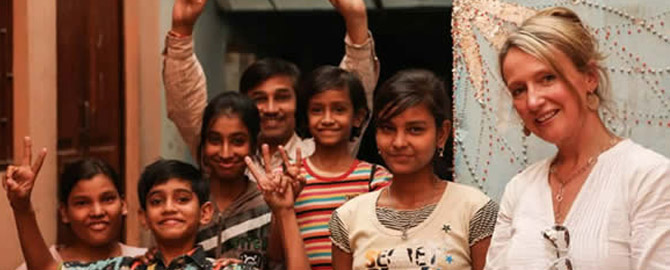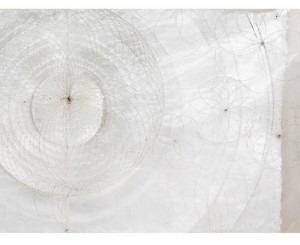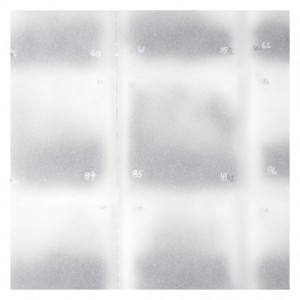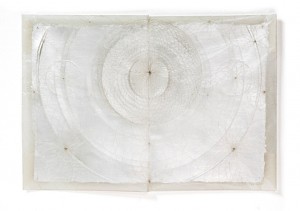
Light 1, 2010-12 Collage incorporating glassine, metallic thread. sliver gilt and khadi paper, 61cm x 42cm Collection of the artist
Louise Rippert’s work has a beauty and clarity that is rarely experienced or enjoyed. Her experimental use of materials on paper- thread, graphite, glassine and gilts – carry a delicacy that celebrates primitive forms, in particular the circle. Rippert marries techniques such as etching, embossing, collaging, stitching, weaving, that together harmonise and exaggerates the beauty and simplicity of the forms she adopts for the focus of her work. Rippert visually documents her connection to India, where she has extensively travelled. She has absorbed the culture, in particular the Indian symbols, which all calmly and quietly manifest itself in Rippert’s work.
In 2002 Rippert graduated with a Master of Fine Arts by Research from Monash University, Caufield, Australia. Her work has been exhibited and collected extensively throughout Australia,
In her own words
What are the processes involved in creating your work?
My creative processes often involve a great deal of trial and error, with the hope in mind that I will eventually discover something new in my visual language. Mostly, when I begin a new piece of work, I either have just a glimmer of an idea of what I am going to make or sometimes none at all. These moments can be a little scary, so I have to muster a kind of blind faith that if I push through the fears I will be able to conjure something new into existence. Initially though, I find I start a work having been drawn to a particular material, colour or simple repetitive shape, which I could have seen anywhere…. cicada wings or honeycomb structures in nature, or sometimes something as simple as the design of a window frame or advent calendar box.
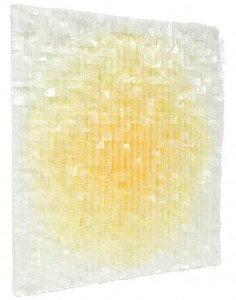
Not Dark Yet, 2011 Collage incorporating drafting film, glassine, pigment,gesso and khadi paper, 97cm x 97.5cm Collection of the artist
I like to arrange and rearrange the material components until I sense some sort of new order or pattern emerging. Repetition seems to be a pretty large factor in my work….so it’s often the case of finding the shape, colour and material that I want to work with then the format in which I’d like to repeat or sequence these ingredients. When I am able to surrender to the journey of creating, or finding by doing, and let go of controlling the absolute outcomes, I find this method of working to be very meditative…which I like, as I feel this meditation, or being in the moment, is essentially the very philosophy which underlies the work. I’ve found that creating works in this way is a very real way of remembering and practicing these same lessons throughout one’s day to day life.
Your images fuse a variety of mixed-media Fine Art materials and techniques. Pulling from so many resources, how do you select what to use and what to disregard from your experiences?
I have always been attracted to materials which “speak” their own language or resonate with a kind of haunting quality or “spirit”. Probably my attraction to many of these materials came from child hood experiences and memories…Transparent materials which let light through such as the glassine paper placed between pages of photo albums… remind me of time passing, memory fading and of conscious and unconscious history. Soft, aged or handmade paper speaks again of time and aging and records a sense of human touch. I used to love visiting the museum as a child…so anything old still evokes that sense of wonder in me.
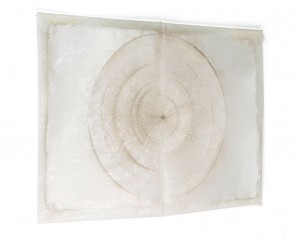
Light 2, 2010-12 Collage; glassine, thread, silver gilt and khadi paper,61cmx43cm Collection of the artist
I tend to use construction methods or techniques which evoke similar sentiments. For example, many of my works incorporate labour-intensive hand stitching and attention to detail. The materials become visual metaphors for the mysterious phenomena of time, thought and transcendence and the process of construction becomes a vehicle for my own meditative practice. I hope, through both materials and method, to draw the viewer’s attention into the works and perhaps lead to them to a moment of self-forgetting.

Recording, 2008 collage; thread, aluminium and silver gilt and pencil on khadi paper 38 x 37 cm Collection of Deakin University
What obstacles do you face in making and exhibiting your work?
Not having enough consistent time in the studio is perhaps the biggest obstacle to my creativity at the moment. Because my work is fairly labour-intensive and physically quite demanding, sometimes taking months to make a single piece of work… preparing a body of work large enough for a solo exhibition can be a very slow process! Because of this time factor I tend to exhibit more within curated or group exhibitions, in which I am only required to put in a few pieces.
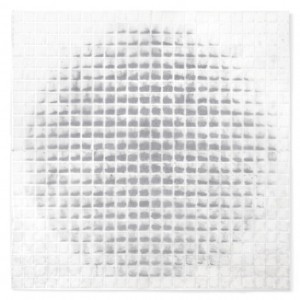
Trace 2008 Collage; pigment baking paper, tracing paper, pencil, thread and adhesive contact on drafting film 94 x 94 cm Collection on the artist
What artists have influenced you, and how?
As a teenager I saw the work of Giorgio de Chirico. The painting Melancholy and Mystery of a Street, 1914, which depicts a small girl approaching a long and threatening shadow captures an eerily haunting moment of potential danger. It is a moment beyond the viewer’s control and we are left powerless to influence or learn of her fate. Although my work is abstract I think there is something of this suspended tension that I have always wanted to capture.
For me, Eva Hesse’s beautiful, spooky and ephemeral work touches the sublime. In fact, I sometimes find its beauty a little disturbing, almost painful to look at!
Having travelled to India many times and being interested in eastern Mysticism, I immediately related to Anish Kapoor’s work…particularly those void pieces which play on creating a moment of “unknowing” as the viewer’s being or consciousness is drawn into a the sculpture’s space, creating again that moment of in-betweenness or self-forgetting .
Why is the artist in a unique position to make statements that cause us to relate?
I think that artists by nature often position themselves outside the traditional structures that demand certain rules of conformity. This leaves them with slightly different sets of values opening their role to be more a position of critic or observer of the community/society/world in which they live. Their creations, which are essentially visual in language, offer the viewer the unique opportunity to engage with the work’s subject matter through their own personal history of experience and understanding.
What do you think the artist offers that say a politician or a leader or a teacher cannot?
A completely personal vision, hopefully unhindered by the influence of opinion polls!
Where do you see yourself in 10 years?
Still making art.
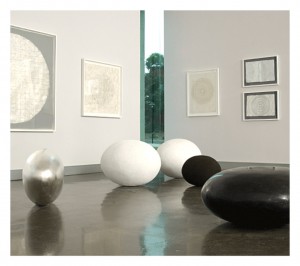
Forms for Remembering 2008 silver leaf, polymer cement, calcium carbonate and black oxide Collection of the artist
Louise Rippert currently lives and works in Australia. In addition to her Art, Rippert worked as a tutor in the painting department and was appointed as acting member of the Deakin University Aquisition Advisory Group. More recently, Rippert has exhibited in a group show- The Blake Prize Exhibition and Touring Exhibition, The Rocks, NSW
All images courtesy of Louise Rippert | www.louiserippert.com.au
For more information on Hong Kong Art Tutoring please contact:
Gail Deayton
Telephone: +852 9722 8353
Email: gd@gaildeayton.com

